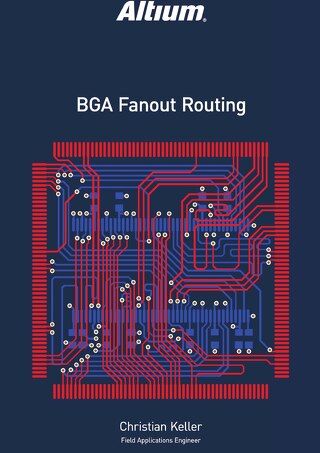Interactive Routing Datasheet

The PCB editor’s advanced routing engine includes push and shove, hug, walk around, and interactive length tuning modes for single-ended and differential pair routes. ™ enable complex signal-path groupings across the PCB to be tuned for any high-speed technology, with the Wizard to automate the setup of modern topologies including DDR2/3/4, USB 3.0, and more. ® provides user-guided routing automation to route and tune across defined layers, giving human-quality results at the speed of a machine. Visual clearance boundaries between traces and components on your board let you see design rules in action helping you understand your layout at a glance.
Altium Designer enables designers to exploit the benefits of both flexible and rigid circuits — where the rigid circuits can carry all or the bulk of the components, and the flexible PCB layers act as interconnections between the multiple boards.
FEATURES AND BENEFITS
- Easily define and manage rigid-flex board designs
- Visualize and verify that your rigid-flex and multi-board PCB accurately folds and fits in its enclosure before sending it to manufacturing to ensure proper fit
- Communicate exact design intent with 3D video clip generation: greatly improves manufacturing accuracy to the intent
- Bring system-level design (multi-board) to electronic product development
- Check connections, collisions, and enclosure fit with the Multi-board 3D Assembly editor to ensure a proper fit before building any hardware
- Easily manage multi-board system connections

Multi-board PCB Design
RIGID-FLEX AND MULTI-BOARD
Many of today’s PCB design projects are far from simple; they require multiple boards, more connectivity, less real estate, more density, higher power, and a much quicker time to market. The good news is, thanks to advancements in EDA technologies, designers now have access to better-suited solutions to these challenges with rigid-flex designs.
Furthermore, Altium Designer does not limit your multi-board design to only those that are permanently connected (rigid-flex) but takes that a step further to provide you with a complete system design solution. This addresses the challenges of interconnected PCBs by bringing them together to ensure they are correctly connected, collision-free, and fit inside the enclosure.
Collision Detection
One of the strengths of the Altium Designer 3D PCB Editor is its capability to check for 3D collisions. You don’t even need to guess whether you can position a component under another, whether the enclosure is going to fit perfectly, or whether some components will collide with unintended areas when you fold your rigid-flex board. Through your PCB Rules and Constraints Editor, you can set Component Clearance rules and be confident you’ll catch any potential collision. And with the option to see the actual violation distance, you can clearly visualize the objects in violation in 3D as you work, as well as the distance between those objects.

Detecting PCB Collisions in 3D as You Work
Interconnected Multi-board Assembly
With circuit boards not existing in isolation and often assembled together with other flex circuit boards, which are then housed inside an enclosure, Altium Designer now supports creating and managing multi-board assemblies. You can define the logical (schematics) structure of the system in a multi-board schematic, with each logical block in the multi-board schematic referring to a physical (PCB) design. Then the physical multi-board design is created by transferring the system design into a multi-board assembly design. This enables designers to verify at the system level how their “child” PCBs are electrically and physically connected while maintaining the integrity of their pin and net connectivity.
Altium Designer gives you the design space to plug together multiple rigid-flex and multi-boards, and the tools to manage the whole system connections, resolve conflicts, and update system-child projects. And with the state-of-the-art 3D multi-board assembly editor, you can have the separate boards rotated, aligned, and plugged into each other. It also allows other parts, including other boards, assemblies, or STEP format MCAD models, to be imported and positioned in the assembly.
Altium Designer brings system-level design capabilities to the electronic product development process so designers can verify if nets have been assigned correctly, connectors are oriented correctly, plug-in boards fit together, and whether all the connected boards fit into the enclosure. This helps minimize any costly, late product development stage mistakes, such as redesigning costs or market delays.

Multi-board Assembly Management
Multi-board Connection Management
Multi-board Projects feature hierarchical document structures that include source documents (multi-board schematic and assembly), and the child PCB sub-projects linked to modules in the schematic system design. Altium Designer establishes the connections between modules in the schematic, ultimately representing the connectivity between child project connectors, connector pins, and nets in the overall system design. Once the multi-board connection is established, Altium Designer makes the system connection complexity simple to manage in the multi-board schematic editing environment through the connection manager dialog. This dialog lists all net/pin assignments, grouped under their parent connection designators and type (wire, direct, etc), and includes their system design ID and Net Name, along with their From and To Pin/Net connections. It provides designers with additional features that may be used to modify, check and update that connectivity as the overall product design is developed. It also includes the conflict resolution section indicating connection conflicts between the current multi-board system design and source (child) projects during a design update.

Multi-board Assembly Connection Management
Rigid-flex Regions with Bend Angles
Whether your application requires a circuit that will undergo minimal flexing, frequent flexing, or it just requires less weight and space, Altium Designer makes it easy to define your rigid-flex board shapes, bend radius and angles, and flex region layer stack. With board movement being controlled with a definable angle, radius, and fold index for rigid-flex regions, you can simulate, with powerful NATIVE 3D, the full motion of how and where your circuit flexes. This full-range animation can be packaged as a video clip to share with your manufacturer to communicate your exact design intent. Having the capability of designing rigid-flex boards, with the simplicity to define and manage them, is even more critical in designs that use multiple folds to fit in tight spaces, allow frequent movement of the flex circuitry, or utilize large components that need to be checked for clearances.
Altium Designer allows you to manage rigid-flex specific board shape definitions, layer stack-up information, range of motion animation, folded state verification, and flex region routing constraints, giving you the confidence that your boards will meet the application requirements, and fit their mechanical enclosures without the time and financial burden of a physical prototype.

Easy Rigid-Flex Back of Board Shapes Design Definition
Looking for more information about Rigid-Flex and Multi-Board PCB Design? Reach out to our support team, or call our toll-free phone number at 1-800-488-0681 today.










